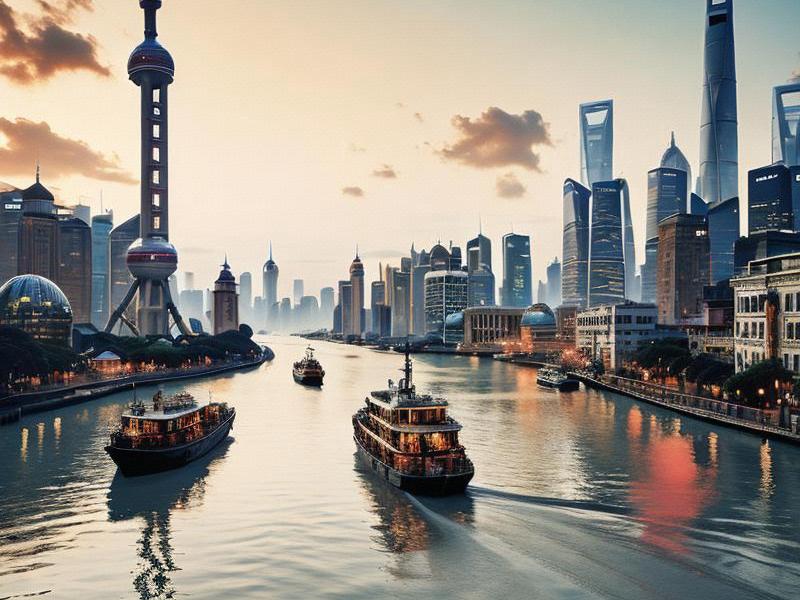This article delves into the remarkable transformation of Shanghai from a historical port city to a global metropolis, exploring its urban development, preservation of cultural heritage, and its growing influence on the world stage.

Nestled along the banks of the Huangpu River, Shanghai stands as a beacon of China's economic and cultural evolution. Once a modest fishing village, it has risen to prominence as one of the world's most dynamic cities, embodying the spirit of modernity and innovation. This article embarks on a journey through Shanghai's past and present, highlighting the factors that have contributed to its renaissance and its ongoing quest for global recognition.
The history of Shanghai is deeply intertwined with its strategic location at the mouth of the Yangtze River, which has made it a vital hub for trade and commerce for centuries. During the 19th century, the city became a treaty port, opening its doors to foreign trade and influence. This period saw the construction of iconic structures such as the Bund, a waterfront area lined with colonial-era buildings that stand as a testament to Shanghai's cosmopolitan past.
The 20th century marked a turning point in Shanghai's history, as the city became a symbol of China's struggle for modernization and independence. The establishment of the People's Republic of China in 1949 brought significant changes to the city, with Shanghai transitioning from a foreign-controlled enclave to a center of socialist development. Despite these shifts, the city's entrepreneurial spirit and cultural vibrancy remained intact, setting the stage for its resurgence in the late 20th century.
The economic reforms initiated in the late 1970s by Deng Xiaoping set the stage for Shanghai's dramatic transformation. The city was designated as one of China's first Special Economic Zones, attracting foreign investment and fostering rapid industrialization. The Pudong area, once a rural backwater, was transformed into a sprawling financial district, home to the iconic Oriental Pearl Tower and the Jin Mao Tower, among other skyscrapers. This period of rapid urbanization saw the construction of modern infrastructure, including highways, subways, and international airports, solidifying Shanghai's status as a global metropolis.
上海品茶网
Shanghai's urban development is not without its challenges. The city has grappled with issues such as population density, environmental sustainability, and the preservation of its historical heritage. However, innovative solutions have been implemented to address these concerns. For instance, the city has invested heavily in green technologies and sustainable urban planning, with initiatives such as the construction of energy-efficient buildings and the expansion of public transportation networks. Additionally, efforts have been made to preserve the city's rich cultural heritage, with restoration projects bringing historic buildings back to life and cultural festivals celebrating Shanghai's unique traditions.
One of the most striking aspects of Shanghai's renaissance is its ability to blend tradition with modernity. The city's historic districts, such as the French Concession and the Old City, coexist with futuristic skyscrapers and cutting-edge technology. This harmonious integration of old and new is evident in areas like Tianzifang, a former textile factory district that has been transformed into a vibrant arts and crafts enclave. Here, visitors can explore boutique shops, art galleries, and cafes, all housed in beautifully restored buildings that pay homage to the area's industrial past.
Cultural preservation is a cornerstone of Shanghai's identity, and the city has taken significant steps to safeguard its heritage. The Shanghai Museum, located in People's Square, is a world-renowned institution that houses an extensive collection of Chinese art, including ancient ceramics, calligraphy, and paintings. The museum's mission is to promote cultural exchange and understanding, attracting visitors from around the globe.
爱上海419论坛
The city's commitment to cultural preservation extends beyond museums and historic districts. Shanghai has also embraced its role as a global cultural hub, hosting international events such as the Shanghai International Film Festival and the Shanghai World Expo. These events not only showcase the city's cultural offerings but also foster international collaboration and dialogue.
Shanghai's influence extends far beyond its borders, as it continues to play a pivotal role in China's economic and political landscape. The city is home to the headquarters of numerous multinational corporations and financial institutions, making it a key player in global commerce. Its strategic location and robust infrastructure have made it a gateway for trade and investment, connecting China to the rest of the world.
The rise of Shanghai as a global metropolis has also had a profound impact on its residents. The city's cosmopolitan atmosphere attracts people from all over the world, creating a diverse and dynamic community. This melting pot of cultures has enriched Shanghai's social fabric, fostering innovation and creativity.
上海娱乐联盟
However, the rapid pace of development has also brought challenges, particularly in terms of social inequality and urban sprawl. The city government has implemented policies aimed at addressing these issues, such as affordable housing initiatives and urban renewal projects. By prioritizing sustainable development and social equity, Shanghai aims to ensure that its renaissance benefits all its residents.
In conclusion, Shanghai's journey from a historical port city to a global metropolis is a testament to the power of resilience, innovation, and cultural preservation. The city's ability to blend tradition with modernity, coupled with its commitment to sustainable development, has positioned it as a model for urban transformation. As Shanghai continues to evolve, it remains a symbol of China's aspirations and a beacon of hope for cities around the world.
The story of Shanghai is one of transformation and triumph, a narrative that resonates with the dreams and aspirations of its people. It is a city that has embraced change while honoring its past, a place where the old and the new coexist in perfect harmony. As we look to the future, Shanghai stands as a shining example of what is possible when a city dares to dream big and act boldly.